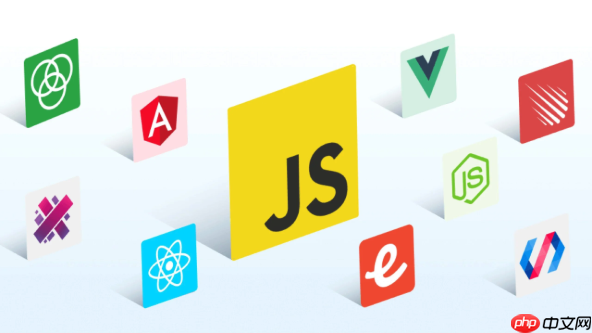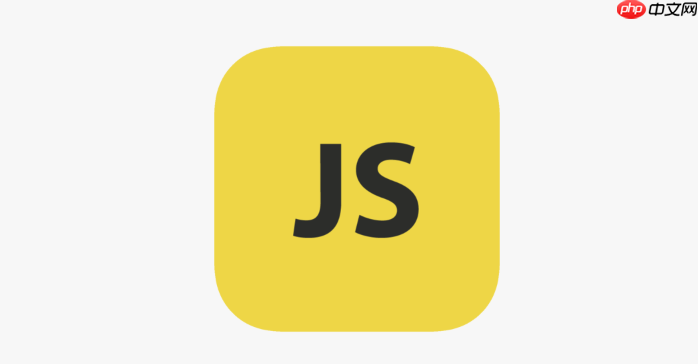es6中super关键字与父类构造函数调用的关系在于,它强制在子类构造函数中调用父类构造函数以完成初始化。1. 在子类构造函数中必须先调用super()才能使用this,确保父类初始化完成;2. super()会绑定this到子类实例,使其后续可安全访问和扩展属性;3. 除了构造函数,super也可用于子类普通方法中调用父类方法,此时this仍指向子类实例;4. 在静态方法中,super用于调用父类静态方法,且this指向当前子类而非父类。

ES6的super关键字,在我看来,它最核心的功能就是提供了一个清晰、直观的机制,让我们在子类中能够方便地访问和调用父类的方法,包括构造函数和普通方法。这大大简化了类继承中的代码复用,避免了直接操作原型链的复杂性。

要使用ES6的super关键字调用父类方法,主要有两种场景:在子类的构造函数中调用父类构造函数,以及在子类的普通方法中调用父类的同名或不同名方法。
1. 在子类构造函数中调用父类构造函数:
这是最常见也最强制的用法。在子类的constructor中,你必须在访问this之前调用super()。这确保了父类部分的初始化得以完成。

class Animal {
constructor(name) {
this.name = name;
console.log(`Animal ${this.name} created.`);
}
speak() {
return `${this.name} makes a sound.`;
}
}
class Dog extends Animal {
constructor(name, breed) {
super(name); // 调用父类Animal的constructor,传入name参数
this.breed = breed;
console.log(`Dog ${this.name} of breed ${this.breed} created.`);
}
speak() {
const parentSound = super.speak(); // 调用父类Animal的speak方法
return `${parentSound} Woof! I'm a ${this.breed}.`;
}
}
const myDog = new Dog('Buddy', 'Golden Retriever');
// 输出:
// Animal Buddy created.
// Dog Buddy of breed Golden Retriever created.
console.log(myDog.speak()); // 输出: Buddy makes a sound. Woof! I'm a Golden Retriever.2. 在子类普通方法中调用父类方法:
在子类的实例方法中,你可以使用super.methodName()来调用父类中定义的方法。这里的this上下文会保持为子类的实例。
class Parent {
greet() {
return `Hello from Parent.`;
}
showThis() {
return `Parent's this is: ${this.constructor.name}`;
}
}
class Child extends Parent {
greet() {
// 调用父类的greet方法,并在此基础上添加内容
return `${super.greet()} Hello from Child.`;
}
showChildThis() {
// 即使调用父类方法,父类方法内部的this仍然指向Child实例
return `Child calling parent's showThis: ${super.showThis()}`;
}
}
const childInstance = new Child();
console.log(childInstance.greet()); // 输出: Hello from Parent. Hello from Child.
console.log(childInstance.showChildThis()); // 输出: Child calling parent's showThis: Parent's this is: Childsuper关键字与父类构造函数调用有什么关系?在ES6的类继承体系中,super关键字在子类构造函数中的作用是至关重要的,它直接扮演了调用父类构造函数的角色。这其实是 JavaScript 语言设计上一个挺有意思的约束。我个人觉得,它强制你先完成父类的初始化,再进行子类的个性化定制,这逻辑上很顺畅,也避免了许多潜在的 this 引用问题。就像盖房子,你得先打好地基,才能往上加层和装修,对吧?

具体来说:
extends关键字),并且它定义了自己的constructor,那么在这个子类的constructor内部,你必须调用super()。如果没有调用,或者在调用super()之前尝试使用this关键字,JavaScript会抛出引用错误(ReferenceError)。super()的调用会执行父类的构造函数,从而初始化父类中定义的属性和方法。这确保了子类实例拥有父类所需的所有基本特性。this: super()的调用还会负责绑定this。在子类构造函数中,this在super()调用之前是不可用的。一旦super()被调用,this就会被正确地初始化并指向子类的实例,你就可以安全地使用this来定义子类特有的属性了。class BaseComponent {
constructor(props) {
this.props = props;
console.log('BaseComponent initialized with props:', this.props);
}
}
class CustomButton extends BaseComponent {
constructor(props, label) {
// 在这里使用this会报错,因为super()尚未被调用
// console.log(this); // ReferenceError
super(props); // 必须先调用父类构造函数
this.label = label; // 现在可以安全地使用this了
console.log('CustomButton initialized with label:', this.label);
}
render() {
return `<button>${this.label} - ${this.props.theme}</button>`;
}
}
const myButton = new CustomButton({ theme: 'dark' }, 'Click Me');
// 输出:
// BaseComponent initialized with props: { theme: 'dark' }
// CustomButton initialized with label: Click Me
console.log(myButton.render()); // <button>Click Me - dark</button>super在普通方法中如何调用父类方法?在子类的普通方法(非静态方法)中,super关键字允许你调用父类中定义的同名或不同名方法。这里有个小陷阱,或者说一个需要特别注意的地方:当你在子类方法里通过 super.methodName() 调用父类方法时,父类方法内部的 this 依然指向的是子类的实例。这很关键,因为它意味着父类方法会作用于子类的属性,而不是父类自身的属性。我第一次遇到这个的时候,也愣了一下,觉得有点反直觉,但仔细想想,这正是多态性的一种体现,非常合理。
调用方式: super.methodName(args)
关键点:
this的指向: 当你通过super.methodName()调用父类方法时,该父类方法内部的this上下文会自动绑定到当前的子类实例。这意味着,如果父类方法中使用了this来访问属性或调用其他方法,它实际上是在操作子类实例的属性和方法。class Product {
constructor(name, price) {
this.name = name;
this.price = price;
}
getDescription() {
return `${this.name} costs $${this.price}.`;
}
// 父类方法中使用this
getFormattedPrice() {
return `$${this.price.toFixed(2)}`;
}
}
class DiscountedProduct extends Product {
constructor(name, price, discount) {
super(name, price);
this.discount = discount;
}
getDescription() {
// 调用父类的getDescription方法,并在此基础上添加折扣信息
const baseDescription = super.getDescription();
const discountedPrice = this.price * (1 - this.discount); // 使用子类实例的price
return `${baseDescription} With a ${this.discount * 100}% discount, it's now $${discountedPrice.toFixed(2)}.`;
}
// 演示父类方法中this指向子类实例
getDiscountedFormattedPrice() {
// super.getFormattedPrice() 内部的 this 依然指向 DiscountedProduct 实例
return `Original: ${super.getFormattedPrice()}, Discounted: $${(this.price * (1 - this.discount)).toFixed(2)}`;
}
}
const laptop = new DiscountedProduct('Laptop', 1200, 0.15);
console.log(laptop.getDescription());
// 输出: Laptop costs $1200. With a 15% discount, it's now $1020.00.
console.log(laptop.getDiscountedFormattedPrice());
// 输出: Original: $1200.00, Discounted: $1020.00 (父类方法中的this.price实际上是子类实例的price)super关键字如何调用父类的静态方法?静态方法中的 super 行为和实例方法中的 super 有些异曲同工之妙,但又有所不同。它同样提供了一个通向父类静态方法的通道。我常觉得,这就像是家族企业里,老一辈的经营理念或决策模式,可以直接被新一代继承和引用,而不需要通过某个具体的‘产品’(实例)来传递。这让类层面的工具函数或辅助方法变得非常灵活。
当你在一个子类的静态方法中,需要调用其父类的静态方法时,同样可以使用super关键字。
调用方式: super.staticMethodName(args)
关键点:
super调用父类静态方法,也是在类级别上进行的。this的指向: 在静态方法中,this指向的是当前类本身(即调用该静态方法的类)。当通过super.staticMethodName()调用父类静态方法时,父类静态方法内部的this也同样指向调用者(子类),而不是父类。这使得父类静态方法可以基于子类的信息进行操作。class Calculator {
static add(a, b) {
return a + b;
}
static multiply(a, b) {
return a * b;
}
static getOperationName() {
return `${this.name} operations`; // 这里的this指向调用者
}
}
class AdvancedCalculator extends Calculator {
static subtract(a, b) {
return a - b;
}
static performCalculations(x, y) {
// 调用父类的静态方法
const sum = super.add(x, y);
const product = super.multiply(x, y);
const sub = this.subtract(x, y); // 调用自身的静态方法
return `Sum: ${sum}, Product: ${product}, Subtraction: ${sub}`;
}
static getAdvancedOperationName() {
// 调用父类静态方法,父类方法中的this指向AdvancedCalculator
return `${super.getOperationName()} (Advanced)`;
}
}
console.log(AdvancedCalculator.performCalculations(10, 5));
// 输出: Sum: 15, Product: 50, Subtraction: 5
console.log(AdvancedCalculator.getAdvancedOperationName());
// 输出: AdvancedCalculator operations (Advanced)
// (因为super.getOperationName()内部的this指向AdvancedCalculator)以上就是ES6的super关键字如何调用父类方法的详细内容,更多请关注php中文网其它相关文章!

每个人都需要一台速度更快、更稳定的 PC。随着时间的推移,垃圾文件、旧注册表数据和不必要的后台进程会占用资源并降低性能。幸运的是,许多工具可以让 Windows 保持平稳运行。




Copyright 2014-2025 https://www.php.cn/ All Rights Reserved | php.cn | 湘ICP备2023035733号